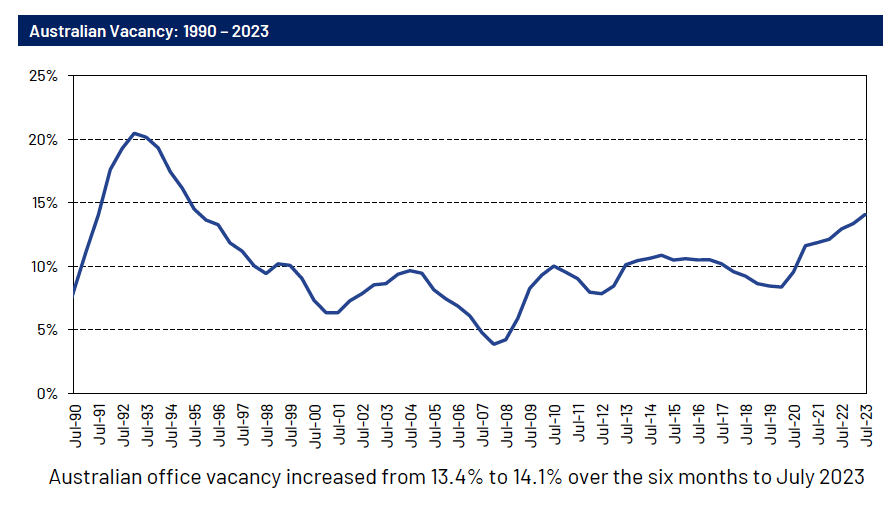This driven by a slight uptick in new office supply

Australia’s capital cities have seen a modest increase in vacancy rates over the last six months, fuelled by an uptick in new office supply, according to data from the Property Council of Australia.
The Office Market Report for July 2023 showed overall CBD vacancy lifted from 12.6% to 12.8% nationally, while in non-CBD areas, the increase was from 15.2% to 17.3%.
According to the bi-annual report, while the Australia-wide vacancy rate increased, the supply of office supply in the CBDs exceeded the historical average in five out of the last seven half-yearly reports. Office supply has exceeded average in three of the last seven reporting periods in Melbourne and three in Sydney.

Source: Office Market Report July 2023, Property Council of Australia.
Brisbane, Perth, Adelaide, and Canberra all recorded strong demand for office space. In Brisbane, demand for office space was 1.4%, while the vacancy rate dropped from 12.9% to 11.6%. In Canberra, vacancy decreased from 8.9% to 8.2%.
Sydney saw a slight rise in the vacancy rate, from 11.3% to 11.5%, and Perth ticked up from 15.7% to 15.9%. Adelaide had a vacancy rate rise from 16.1% to 17%, and Melbourne’s increased from 14.1% to 15%.

Source: Office Market Report July 2023, Property Council of Australia.
Mike Zorbas (pictured above), Property Council CEO, said the figures showed Brisbane demonstrated a strong performance over the past half year, while Melbourne and Sydney were facing some challenges that require attention.
“Demand remains strong in four of the six capital cities captured in our detailed survey, but it has subsided across the big two, Sydney and Melbourne,” Zorbas said. “The office market in Brisbane is particularly robust, with tenant demand outpacing available supply, decreasing the vacancy rate from 12.9% to 11.6%.
“Overall, demand for CBD office space nationally is fairly stable, slightly dropping to negative territory after a year and a half of positive demand.
The results notably showed high demand for Premium and A Grade, which according to the Property Council chief reinforced “businesses’ desire to provide attractive and enjoyable workplaces for their people,” Zorbas said.
"These organisations recognise that maintaining a physical office presence in our cities is vital for conducting business effectively,” Zorbas said. “We know that face-to-face teamwork supports deeper team relationships and brings about positive outcomes for organisations, the economy, and society at large.”
Despite big advances in workplaces over the past decade through flexibility in ways of working, there’s still a need for governments to support the vibrancy of CBDs, he said.
“Thriving CBDs are an essential part of our national economic prosperity and support the viability of large-scale public transport systems and investments in public amenities,” Zorbas said.
“We need parliaments and public- and private-sector leaders to recognise and champion the superior relationships, organisational, economic, and societal outcomes that come from face-to-face teamwork in cities and towns across our nation each and every week.”
Office stock in CBD markets is forecasted to remain close to the historical average throughout 2023, with an anticipated above-average increase in the second half of next year. Non-CBD markets, meanwhile, were predicted to experience a higher-than-average supply in the first half of 2024, followed by a decline in the subsequent year.
Sublease vacancy rose in the non-CBD market but remained steady in the CBD market, with only Sydney and Melbourne above the historical average.
“Sydney and Melbourne experienced slight vacancy rate increases with over 200,000 sqm of new office space planned in the next three years,” Zorbas said. “However, pre-commitment rates are lower than Brisbane, with only 42% in Sydney and 17.4% in Melbourne already secured by tenants.”
Access the full details about the Office Market Report and July results here.
Use the comment section below to tell us how you felt about this.



